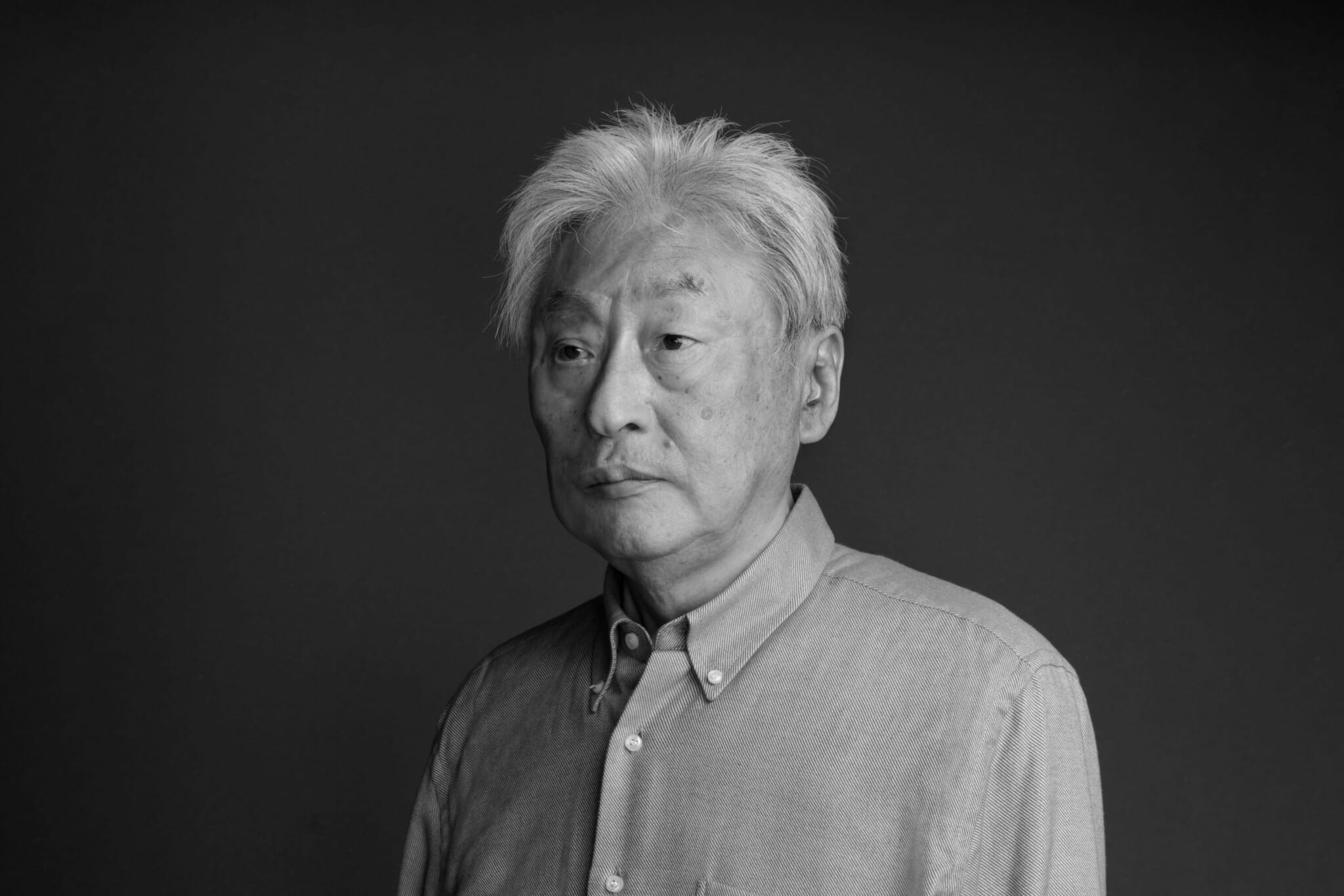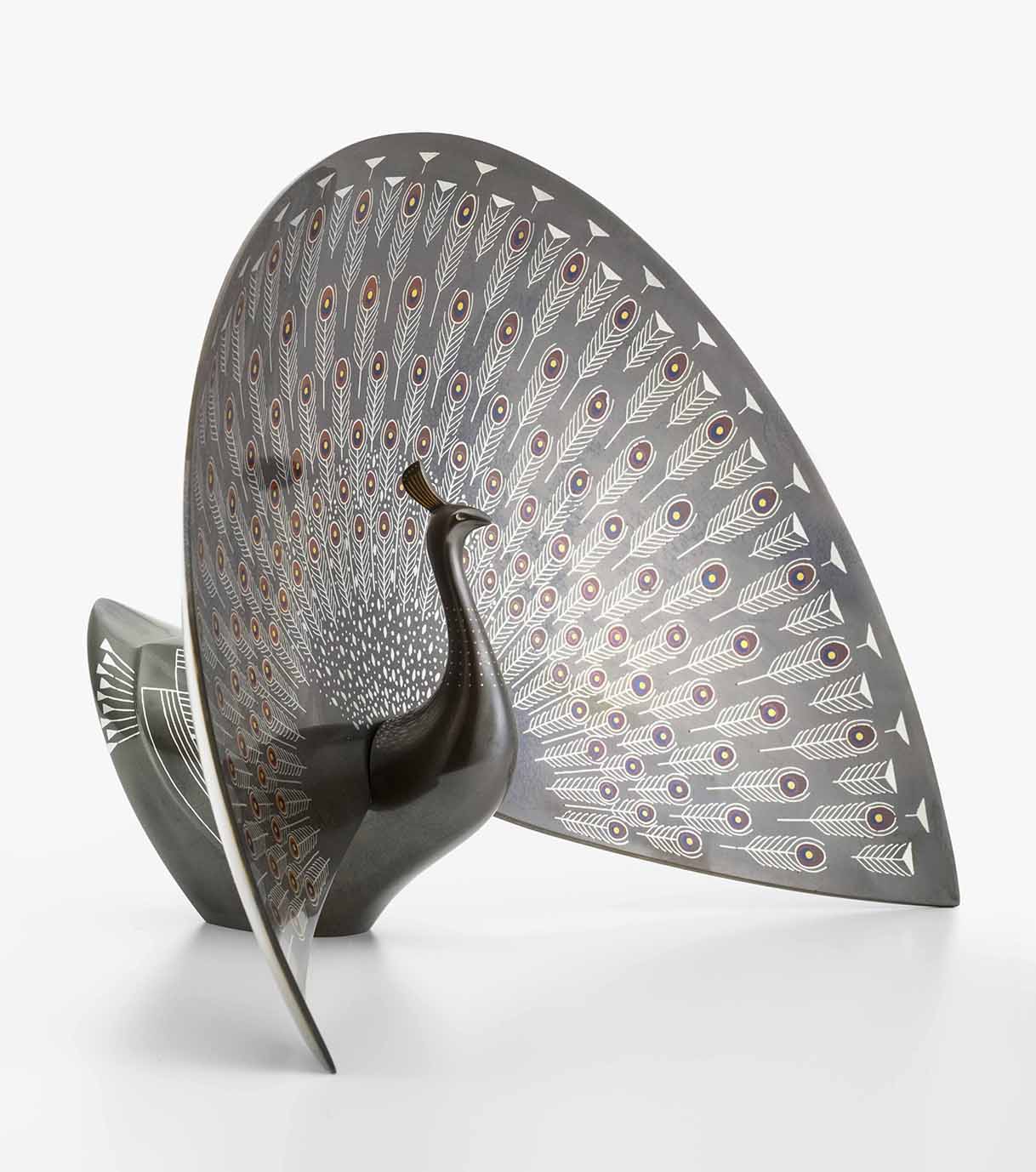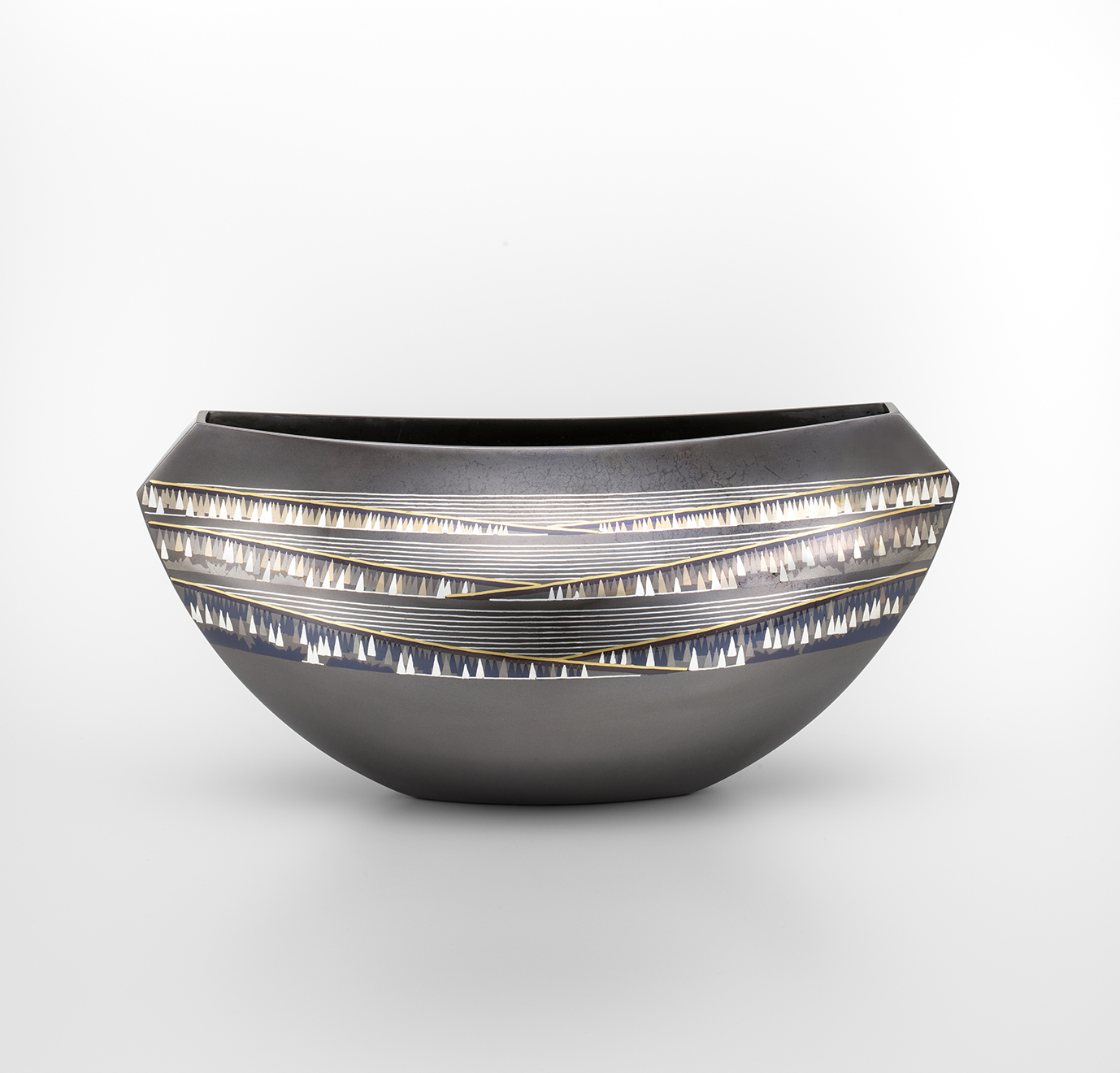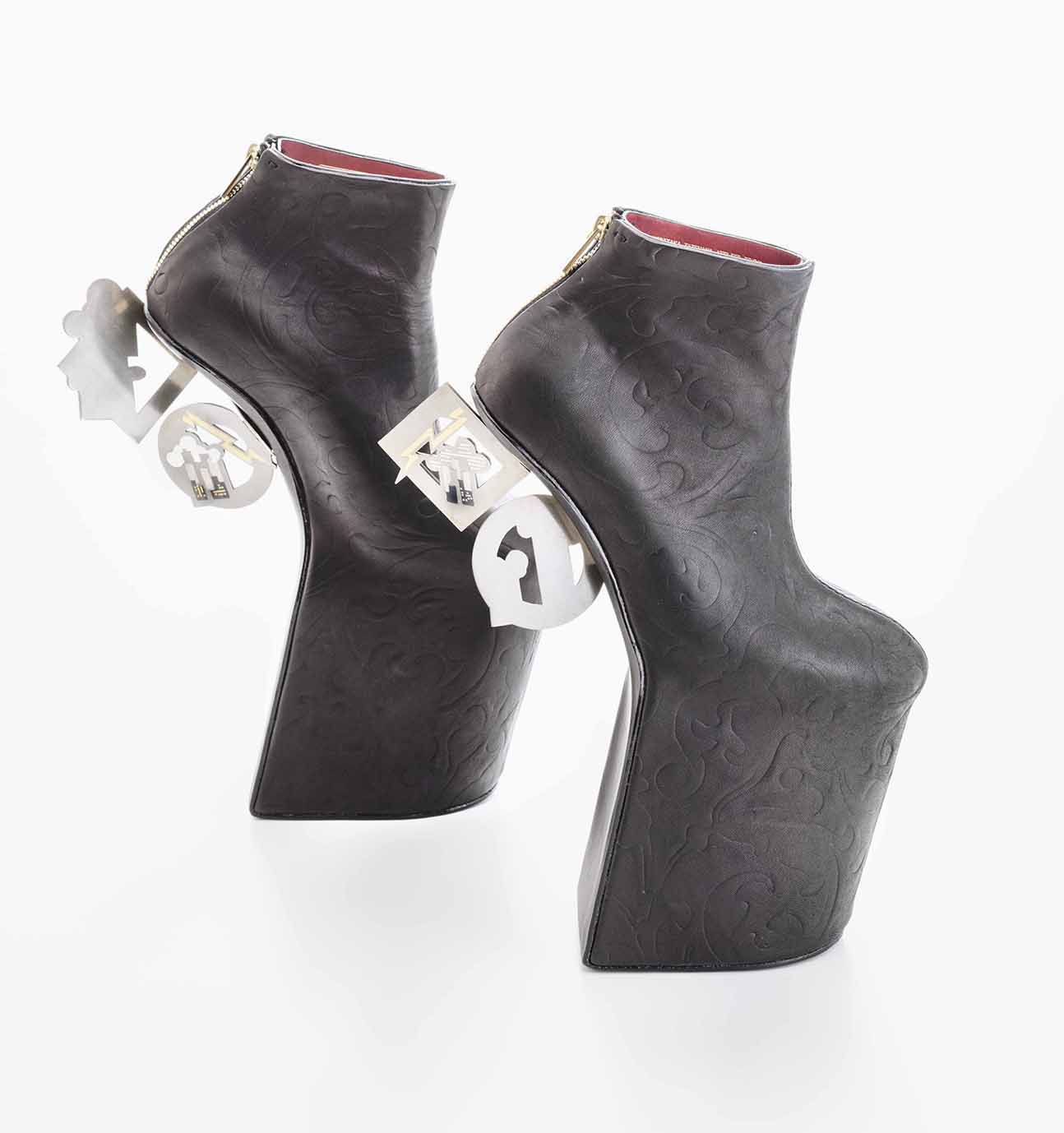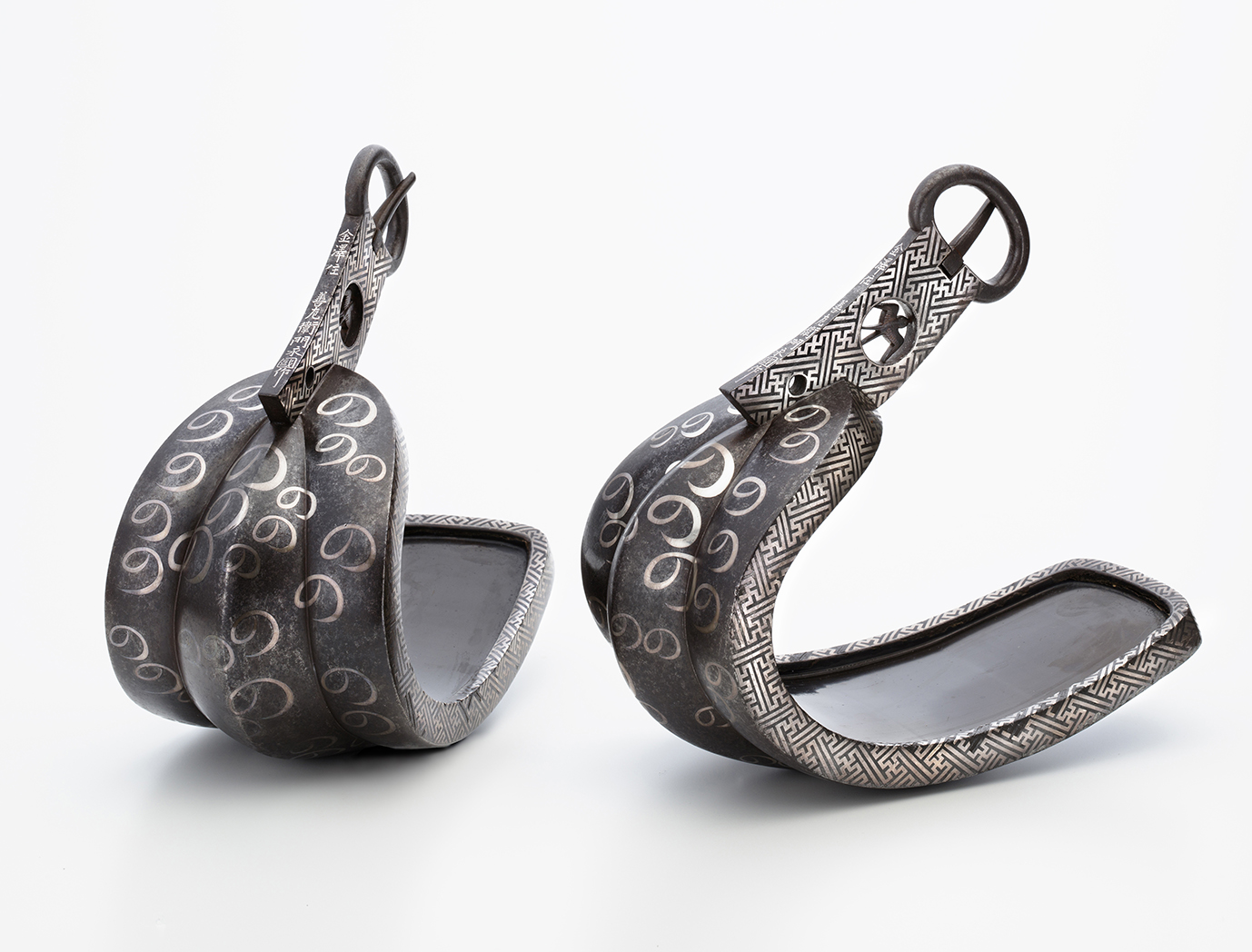The clinking sound of hammer hitting chisel rings through the workshop of Mamoru Nakagawa, an artisan in his mid-70s. He taps persistently with fierce concentration, carving grooves in a smooth alloy surface. Nakagawa practices Kaga metal inlay, or Kaga zogan in Japanese, a craft that once thrived in the area known today as Kanazawa, Ishikawa Prefecture. Metal inlay entails inserting ultra-thin pieces of soft metal, sometimes less than a millimeter thick, into cavities cut into a harder base. The finished works are astounding objects of gleaming beauty that look entirely as if their decorative designs were painted or printed, rather than painstakingly engraved and embedded by hand. Nakagawa has honed his art over nearly half a century, leveraging an industrial design background to unite a traditional craft with modern aesthetics. For its 20th anniversary exhibition, Panasonic Shiodome Museum of Art in Tokyo chose to spotlight this living national treasure, a former Panasonic employee.
“Nakagawa Sensei creates remarkable artworks, but in many ways his life is relatable, since he started out as a company worker,” curator Yuko Kawakita notes. “We also believe his design-centered approach could make the lofty-seeming world of metalcraft more accessible.”
Dressed in a blue blazer with a shock of white hair, Nakagawa exudes a candid, affable air. “I was a real Tom Sawyer as a kid, always building tree forts and flying toys,” he says.
Industrial design was a natural career choice. After studying it at the Kanazawa College of Art under modern design icon Sori Yanagi and Good Design Awards founder Takuo Hirano, Nakagawa joined Matsushita Electric Works (now Panasonic) in Osaka as a product developer. Projects from his university and company days, including a best-selling hair dryer and sketches for electric razors, demonstrate a clean sharpness of lines still found in his metalwork.
Encounters with Craft
“I would’ve stayed at Matsushita if I hadn’t had family obligations as the eldest son,” Nakagawa explains. His mother’s illness took him back to his hometown of Kanazawa at age 26, but he continued to pursue design. He worked for the Industrial Research Institute of Ishikawa, experimenting with materials and advising makers of traditional crafts on how to create items suited to the contemporary market. Among his covetable collaborations is a lacquer sake set for New Year’s featuring a spinning top for its lid. “The creative process is the same for craft and industrial design,” he stresses, pointing out a mutual requirement that form follows function with an end user in mind. “Craft,” he continues, “is art with technique.”
The lines between art, craft and design are generally blurry, but the discussion is especially complex in Japan, where craft traditions predate Western hierarchical ideas of “fine” and “applied” arts imposed during the Meiji era. It was an exhibition of Kaga metal inlay during its pre-Meiji golden era that first drew Nakagawa to the artform. After seeing Kaga zogan stirrups — strikingly chic even by today’s standards — made for samurai in the 17th century, he embarked on his journey of mastering and promoting this art with the essence of Japanese craftsmanship in its DNA.
Nakagawa became the last working apprentice of Kaishu Takahashi (1905–2004), a preeminent Kaga zogan artist whose exquisitely detailed works reflect tastes and motifs carried over from the Meiji period. Still, he pushed Nakagawa toward originality and innovation in his own designs. “He always told me, ‘make it haikara’ (high collar),” referring to the progressive fashions of a modernizing Japan. Like Takahashi, Nakagawa also sometimes incorporates archetypal Japanese motifs, but his pieces display a more streamlined style, often with hints from Art Deco.
A Legacy of Sophistication
Kanazawa is known for its rich craft heritage even within Japan. In addition to metal inlay, Wajima and Yamanaka lacquer, Kutani porcelain, and Kaga yuzen silk dyeing are a few of its creative disciplines. Kaga Province was incredibly wealthy during the Edo period, to the point of seeming like a potential rival to the shogunate. Kaga channeled its vast resources into cultural rather than military development in part to allay Tokugawa suspicions.
While Kaga zogan follows the basic process of metal inlay that flourished in Anatolia some 5,000 years ago, the technique was refined in Japan, with a focus on employing alloys for greater color variety. Nakagawa favors a hazily silver-toned blend of copper and silver, known as oborogin, for his base pieces inspired by forms from everyday life. His advanced skills allow him to practice the complex art of multilayered kasane zogan, which requires extreme precision and an intricate understanding of metallic reactions.
“Dawn in the Northern Forest” (2016) exemplifies his process and style. He first sketched an early morning landscape observed in Sweden, then translated the image into metal by carving his design into an oborogin vase using self-made chisels. Next, he fastidiously set and hammered in pieces of gold, silver, copper and alloyed metals, composing a scene of lines and triangles to express trees reflected in water. Finally, the piece was given a steaming chemical bath for patination and polished with grated daikon radish. This particular work was donated to Panasonic, but others of its caliber have been exhibited at institutions such as the Metropolitan Museum of Art and the British Museum. Nakagawa created “Check and Checkered” (2017), combining tartan and Japanese ichimatsu checker motifs, at the suggestion of a British Museum curator.
Looking to the Future
Reflecting on design since Japan’s postwar “economic miracle,” Nakagawa laments diminished enthusiasm for older practices, commenting that kogei (craft) fell by the wayside as Japanese technology underwent reforms. “You don’t often hear mingei (folk crafts) mentioned in industrial design now, but I’d like to see traditional Japanese techniques used more often. To me, that’s where the real ‘Cool Japan’ is.”
With this in mind, he is actively nurturing the next generation of artisans and spreading knowledge of Kaga metal inlay through global travel, teaching and research. The Panasonic show presents recent applications of metalcraft in fields such as jewelry and architecture, along with works by artists following in Nakagawa’s footsteps. His collaborators include Noritaka Tatehana, best known for the Heel-less Shoes worn by Lady Gaga. Together they produced two new pairs for the exhibition, with Nakagawa supplying spur-like pieces attached to Tatehana’s embossed leather uppers. Tatehana observes: “It is rare for a living national treasure to be willing to collaborate with young artists, but traditional crafts will fall into disuse if they are merely regarded as cultural assets to be preserved. Mr. Nakagawa’s gaze is always fixed on the future, while also reflecting on the past.”
His designation as a living national treasure in 2004 recognized not only Nakagawa’s artistry, but also his contributions to furthering the practice of Kaga metal inlay. Interpreting the award as a call to continue advancing his art, he embodies the principle that tradition lives on by seeking out the new.
Find more of Mamoru Nakagawa’s work at the “Nakagawa Mamoru: Design and the Lustrous Beauty of Metal” exhibition, currently being held at Panasonic Shiodome Museum of Art.
Updated On August 25, 2023

